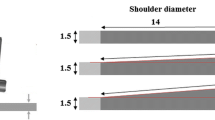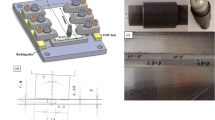Abstract
Tailor welded blanks (TWBs) are produced by welding blanks with different characteristics as such thickness and/or coating and/or material, etc. The forming characteristics of a TWB are different from typical sheets, as TWB is a combined blank each section has its own forming behavior. The current investigation aims to analyze the formability characteristics of TWBs made by joining AA6061 aluminum alloy sheets with different thicknesses. The sheets were joined by friction stir welding (FSW) and also by an improved FSW entitled friction stir vibration welding (FSVW) method at different welding speeds, rotational speeds, and tool tilt angles. The Taguchi method was used for the design of experiments and mean analysis was applied to find the optimum values of welding processes. ANOVA was applied to find the effect of the welding processes on formability. The formability of the TWBs has been assessed with the help of the limiting dome height (LDH) criterion. According to optical microscopy (OM) and electron backscatter diffraction (EBSD) analyses, grains in the stir zone of FSVW-ed blanks were smaller than those in FSW-ed blanks. It was shown that based on the Frank-Read dislocation mechanism, the density of dislocations increased as vibration used during FSW. From the results, it was concluded that the mechanical and formability behaviors of FSVW-ed blanks were higher than those of the FSW-ed blanks. It was also obtained that for the welding speed range studied in the current research, formability and mechanical behaviors of TWBs increased as welding speed increased.





















Similar content being viewed by others
References
Abbasi M, Bagheri B, Ketabchi M, Haghshenas DF (2012) Application of response surface methodology to drive GTN model parameters and determine the FLD of tailor welded blank. Comp Mater Sci 53:368–376
Choi HS, Ko DCh, Kim BM (2014) Effect of weld line orientation on formability of tailor welded blank of 22MnB5 at elevated temperature. Adv Mech Eng 16:2014
Sheng ZQ (2008) Formability of tailor-welded strips and progressive forming test. J Mater Process Technol 205(1–3):81–88
Parente M, Safdarian R, Santos AD, Loureiro A, Vilaca P, Jorge RMN (2015) A study on the formability of aluminum tailor welded blanks produced by friction stir welding. Int J Adv Manuf Technol 83:2129–2141
Abbasi M, Bagheri B, Ketabchi M, Menhaj A, Sedighi M (2012) Investigation into tearing of tailor welded blanks. Proceedings of the 14th International Conference on Metal Forming. Steel Res In 83:583–588
Salimi S, Bahemmat P, Haghpanahi M (2018) Study on residual stresses caused by underwater friction stir welding: FE modeling and ultrasonic measurement. Proc IMechE Part E: J Proc Mech Eng 233(1):118–137
Panicker SS, Panda SK (2019) Investigations into improvement in formability of AA5754 and AA6082 sheets at elevated temperatures. J Mater Eng Perform 28:2967–2982
Miles MP, Decker BJ, Nelson TW (2004) Formability and strength of friction-stir-welded aluminum sheets. Metall Mater Trans A 35(A):3461–3468
Abbasi M, Ketabchi M, Shakeri HR, Shafaat MA (2011) Obtaining high formability of IF-galvanized steel tailor welded blanks by applying optimum CO2 laser welding parameters. Int J Mat Res 102:1295–1302
Khalkhali A, Sarmadi M, Sarikhani E (2016) Investigation on the best process criteria for lap joint friction stir welding of AA1100 aluminum alloy via Taguchi technique and ANOVA. Proc IMechE Part E: J Proc Mech Eng 231(2):329–342
Abbasi M, Hamzeloo SR, Ketabchi M, Shafaat MA, Bagheri B (2014) Analytical method for prediction of weld line movement during stretch forming of tailor-welded blanks. Int J Adv Manuf Technol 73:999–1009
Keivani R, Bagheri B, Sharifi F, Ketabchi M, Abbasi M (2013) Effects of pin angle and preheating on temperature distribution during friction stir welding operation. Trans Nonferrous Metal Soc China 23(9):2708–2713
Jafari M, Abbasi M, Poursina D, Gheysarian A, Bagheri B (2017) Microstructures and mechanical properties of friction stir welded dissimilar steel-copper joints. J Mech Sci Technol 31(3):1135–1142
Gao S, Wu CS, Padhy GK (2017) Material flow, microstructure and mechanical properties of friction stir welded AA 2024-T3 enhanced by ultrasonic vibrations. J Manuf Proc 30:385–395
Abbasi M, Abdollahzadeh A, Omidvar H, Bagheri B, Rezaei M (2016) Incorporation of SiC particles in FS Welded zone of AZ31 Mg alloy to improve the mechanical properties and corrosion resistance. In J Mater Res 107:566–572
Leitao C, Zhang BK, Padmanabhan R, Rodrigues DM (2011) Influence of weld geometry and mismatch on formability of aluminium tailor welded blanks: numerical and experimental analysis. Sci Technol Weld Join 16(8):662–668
Kim D, Lee W, Kim J, Kim C, Chung K (2010) Formability evaluation of friction stir welded 6111-T4 sheet with respect to joining material direction. Int J Mech Sci 52(4):612–625
Rodrigues DM, Loureiro A, Leitao C, Leal RM, Chaparro BM, Vilaça P (2009) Influence of friction stir welding parameters on the microstructural and mechanical properties of AA 6016-T4 thin welds. Mater Des 30(6):1913–1921
Ericsson M, Sandstrom R (2003) Influence of feed rate on the fatigue of friction stir welds, and comparison with MIG and TIG. Int J Fatigue 25:1379–1387
Lee W, Chung KH, Kim D, Kim J, Kim Ch, Okamoto K, Wagoner RH, Chung K (2009) Experimental and numerical study on formability of friction stir welded TWB sheets based on hemispherical dome stretch tests. In J Plast 25:1626–1654
Golezani AS, Barenji RV, Heidarzedh A, Pouraliakbar H (2015) Elucidating of tool rotational speed in friction stir welding of 7020-T6 aluminum alloy. In J Adv Manuf Technol 81:1155–1164
Kesharwani RK, Panda SK, Pal SK (2015) Experimental investigations on formability of aluminum tailor friction stir welded blanks in deep drawing process. J Mater Eng Perform 24(2):1038–1049
Bagheri B, Abbasi M, Dadaei M (2020) Effect of water cooling and vibration on the performances of friction stir-welded AA5083 aluminum joints. J Metall Micro Anal 9:33–46
Barooni O, Abbasi M, Givi M, Bagheri B (2017) New method to improve the microstructure and mechanical properties of joint obtained using FSW. Int J Adv Manuf Technol 93:4371–4378
Yang Ch, Wu ChS, Shi L (2020) Effect of ultrasonic vibration on dynamic recrystallization in friction stir welding. J Manuf Proc 56:87–95
Rahmi M, Abbasi M (2017) Friction stir vibration welding process: modified version of friction stir welding process. In J Adv Manuf Technol 90:141–151
Liu XC, Wu CS, Padhy GK (2015) Improved weld macrosection, microstructure and mechanical properties of 2024Al-T4 butt joints in ultrasonic vibration enhanced friction stir welding. Sci Technol Weld Join 20:345–352
Padhy GK, Wu CS, Gao S, Shi L (2016) Local microstructure evolution in Al 6061-T6 friction stir weld nugget enhanced by ultrasonic vibration. Mater Des 92:710–723
Wu M, Wu ChS, Gao S (2017) Effect of ultrasonic vibration on fatigue performance of AA 2024-T3 friction stir weld joints. J Manuf Proc 29:85–95
Hosford WF, Caddell RM (1993) Metal Forming – Mechanics and metallurgy, 2nd edn. Prentice Hall, Hoboken
Padmanabhan R, Oliveira MC, Menezes LF (2008) Deep drawing of aluminum-steel tailor-welded blanks. Mater Des 29:154–160
Bagheri B, Abbasi M (2020) Development of AZ91/SiC surface composite by FSP: Effect of vibration and process parameters on microstructure and mechanical characteristics. Adv Manuf 8:82–96
Heidarzadeh A, Saeid T, Klemm V (2016) Microstructure, texture, and mechanical properties of friction stir welded commercial brass alloy. Mater Character 119:84–91
Li YS, Zhang Y, Tao NR, Lu K (2009) Effect of the Zener- Hollomon parameter on the microstructure and mechanical properties of Cu subjected to plastic deformation. Acta Mater 57:761–772
Jonas JJ, Quelennec X, Jiang L, Martin E (2009) The avrami kinetics of dynamic recrystallization. Acta Mater 57:2748–2756
Khorrami MS, Kazeminezhad M, Kokabi AH (2012) Mechanical properties of severely plastic deformation aluminum sheets joined by friction stir welding. Mater Sci Eng A 543:243–248
Fouladi S, Abbasi M (2017) The effect of friction stir vibration welding process on characteristics of SiO2 incorporated joint. J Mater Proc Technol 243:23–30
Wang B, Lei BB, Zhu JX, Feng Q, Wang L, Wu D (2015) EBSD study on microstructure and texture of friction stir welded AA5052-O and AA6061-T6 dissimilar joint. Mater Des 87:593–599
Yadav D, Bauri R (2012) Effect of friction stir processing on microstructure and mechanical properties of aluminium. Mater Sci Eng A 539:85–92
Suhuddin UFHR, Mironov S, Sato YS, Kokawa H (2010) Grain structure and texture evolution during friction stir welding of thin 6016 aluminum alloy sheets. Mater Sci Eng A 527:1962–1969
Fonda RW, Knipling KE (2011) Texture development in friction stir welds. Sci Technol Weld Join 16:288–293
Frigaard Ø, Grong Ø, Midling OT (2001) A process model for friction stir welding of age hardening aluminum alloys. Metall Mat Trans A 32:1189–1200
Wang YN, Chen SJ, Dong XC (2007) Dislocation theory and its applications. Metall In Press, Beijing, pp 62–75
Bagheri B, Abbasi M, Dadaei M (2020) Mechanical behavior and microstructure of AA6061-T6 joints made by friction stir vibration welding. J Mater Eng Perform 29:1165–1175
Cizek L, Gregera M, Pawlicaa L, Dobrzanskib LA, Tanskib T (2004) Study of selected properties of magnesium alloy AZ91 after heat treatment and forming. J Mater Proc Technol 157–158:466 – 71
Chang CI, Lee CJ, Huang JC (2004) Relationship between grain size and Zener– Holloman parameter during friction stir processing in AZ31 Mg alloys. Script Mater J 51:509–514
Abbasi M, Abdollahzadeh A, Bagheri B, Omidvar H (2015) The effect of SiC particle addition during FSW on microstructure and mechanical properties of AZ31 magnesium alloy. J Mater Eng Perform 24:5037–5045
Bagheri B, Abbasi M, Abdollahzadeh A, Omidvar H (2020) Advanced approach to modify friction stir spot welding process. Metal Mater Int 26:1562–1573
Rose AR, Manisekar K, Balasubramanian V (2012) Influence of welding speed on tensile properties of friction stir welded AZ61 magnesium alloy. J Mater Eng Perform 21:257–265
Yang DZ (1991) Dislocation and metal strengthening mechanism. Harbin Institute of Technology Press, Harbin, pp 107–134
Uthaisangsuk V (2009) Microstructure based formability modeling of multiphase steels. Ph. D. Thesis, IEHK, RWTH- Aachen
Bagheri B, Abbasi M, Abdollahzadeh A, Mirsalehi SE (2020) The effect of second phase particle size and presence of vibration on AZ91/SiC surface composite layer produced by FSP. Trans Nonferrous Metal Soc China 30:905–916
Abdollahzadeh A, Bagheri B, Abbasi M, Kokabi AH, Moghaddam AO (2021) Comparison of the weldability of AA6061-T6 joint under different friction stir welding conditions. J Mater Eng Perform 30:1110–1127
Bagheri B, Abbasi M, Hamzeloo R (2020) The investigation into vibration effect on microstructure and mechanical characteristics of friction stir spot vibration welded aluminum: Simulation and experiment. Proc In Mech Eng Part C: J Mech Eng Sci 234(9):1809–1822
Uthaisanguk V, Bleck W (2009) Microstructure based formability modelling of multiphase steels. Shaker Verlag, Herzogenrath
Lijay Kj, Selvam JDR, Dinaharan I, Vuay SJ (2016) Microstructure and mechanical properties characterization of AA6061/TiC aluminum matrix composites synthesized by in situ reaction of silicon carbide and potassium fluotitanate. Trans Nonferrous Metal Soc China 26:1791–1800
Rajendran C, Srinivasan K, Balasubramanian V, Balaji H, Selvaraj P (2019) Effect of tool tilt angle on strength and microstructural characteristics of friction stir welded lap joints of AA2014-T6 aluminum alloy. Trans Nonferrous Metal Soc China 29:1824–1835
Hull D, Bacon DB (2011) Introduction to dislocations. Butterworth-Heinemann, Britain, pp 87–95
Acknowledgements
The authors would like to thank the Amirkabir University of Technology (AUT), University of Kashan and, National Elites Foundation of Iran for their support during this research.
Author information
Authors and Affiliations
Corresponding author
Ethics declarations
Conflict of interest
The authors declared no potential conflicts of interest with respect to the research, authorship, and/or publication of this paper.
Additional information
Publisher’s Note
Springer Nature remains neutral with regard to jurisdictional claims in published maps and institutional affiliations.
Rights and permissions
About this article
Cite this article
Abbasi, M., Bagheri, B., Abdollahzadeh, A. et al. A different attempt to improve the formability of aluminum tailor welded blanks (TWB) produced by the FSW. Int J Mater Form 14, 1189–1208 (2021). https://doi.org/10.1007/s12289-021-01632-w
Received:
Accepted:
Published:
Issue Date:
DOI: https://doi.org/10.1007/s12289-021-01632-w




